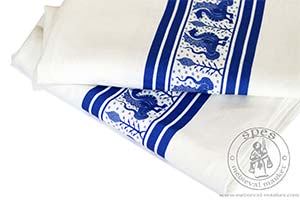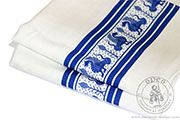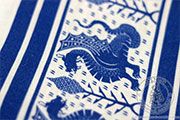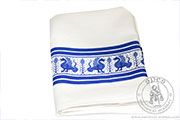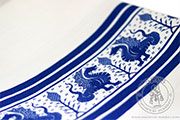If you wish to adjust your cookie preferences for this website, you can do so using your browser settings.
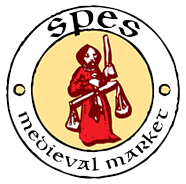


Category: Accessories > Do-It-yourself
Printed linen Florence Dragons pattern
Printed linen Florence Dragons pattern
Century: XV| CODE | Material |
Standard
|
Price | |
| NoR1592 | see description | Mixed | 35.00 EUR |
|
Lowest price in the last 30 days
See how to place an order for several people
If the medieval tablecloth available in our offer does not match the dimensions of your table, don't worry, you can buy the material itself and create a tablecloth, table runner, placemats for plates or other table decorations on your own. Or maybe you would like to sew something from it? The decision is yours.
White linen, printed on the sides with a fantastic pattern in blue. There are fantastic creatures(similar to dragons) and decorations referring to Florentine vegetation. The theme is based on the Florentine fresco from the 15th century.
The material is 150 cm wide. Price per 1 meter.
The mentioned tablecloth, made of this material, you can find here!
Source for the pattern on white linen
The blue printing from our printed linen is based on the fresco by Domenico Ghirlandaio, presenting the Last Supper. You can find it in the refectory of a monastery beside the Ognissanti church, Florence. The work is dated back to 1480. It delights with its details and texture of used materials. The cloth on the picture has fantastic decorations on its edges, which have become a pattern for our material.What do we know about historical "printing" on linen canvases?
The technique of printing canvases, incl. in the 14th-15th centuries was a very popular method of decorating middle class or court outfits.
Medieval Italian artist Cennino Cennini in his book “The Book Of The Art" presented various techniques of applying paint to various types of materials. Among the topics he touched upon were "The way to work on cloth by printing from a shape in colour".
To create a form for printing, you first had to prepare a block of wood, preferably made of walnut or pear, the size of a brick. On the bottom of the block, a pattern had to be drawn and carved, without omitting any details, but in such a way that it was complete from all sides. Copy block should have a handle. Then, using a special glove, the paint (previously prepared, most often black) was taken and spread over the grooved surface. Before putting the form on the canvas, it had to be stretched strongly on a loom. The printing block was applied very tightly and rubbed with it until the ink was settled on the material. You had to be very careful and precise so that the pattern would not be shifted or that there were no gaps between the fragments.
What is more, to make the final effect more interesting, black was combined with some other color. Most often with yellow, red and green. Using a brush, additional colors were filled in animal figures, foliage or fantastic creatures. This way of decorating was perfect for green, red, black, yellow and blue (and even pale blue) canvases. The most important thing was that the colors should contrast with each other, be lighter or darker (e.g. indigo was used on red material, cinnabar on green, etc.).
However, it was important to produce printed linen “(...) which to your fancy it seems you can put together, and one thing will teach you another (...): every art is in its nature ingenious and pleasing: chi ne piglia se n’'ha (he that takes, hath).”.





 Female Clothing
Female Clothing Male clothing
Male clothing
 Furniture
Furniture Tents
Tents Armament
Armament HMB Line
HMB Line Miscellaneous
Miscellaneous Rent
Rent In stock
In stock Special Offers
Special Offers Search
Search Your Account
Your Account About us
About us Sizing
Sizing How to buy
How to buy Blog
Blog Links
Links Events
Events
